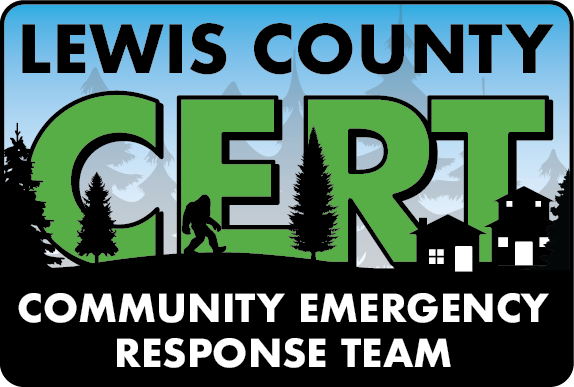CERT

What is a Community Emergency Response Team?
The Community Emergency Response Team (CERT) is a Federal Emergency Management Agency (FEMA) program that educates residents about disaster preparedness for the hazards that may impact their area and trains them in basic disaster response skills, such as fire safety, light search and rescue, team organization, and disaster medical operations. CERT members are trained to safely respond to an emergency on the family, neighborhood and community level, and can provide assistance when first responders are unavailable. CERT members also are encouraged to support emergency response agencies by taking a more active role in emergency preparedness projects in their community.
Events
There are no upcoming events to show at this time.
About Lewis County CERT
Lewis County's CERT is a free, community-based, all-volunteer program. You are eligible to join if you live within Lewis County for our CERT program. Enter your ZIP Code, if outside Lewis County, and find the nearest CERT program to you. Training includes both online and in-person activities from trained professionals.
Lewis County's CERT Program Pathways
Lewis County Emergency Management invites residents who live in Lewis County to become a member of our CERT team. There are three different pathways that a volunteer can choose to participate in for their community. Each pathway requires a different set of requirements beyond the CERT basic course. The three types for the community are CERT Team Volunteer, CERT Team Leader, and CERT Section Chief.
Below you will find our CERT Volunteer Pathways: the choice is yours and solely depends on the level of involvement you would like to have within our CERT program.
CERT Team Volunteer
The Community Emergency Response Team (CERT) Volunteer is a voluntary CERT team member who has training in basic disaster response skills, such as fire safety, light search and rescue, team organization or disaster medical operations.
For Team Volunteer there are Type 1 and Type 2 skills. The requirements for Type 2 include the following training:
- IS 100: Introduction to the Incident Command System, ICS-100
- IS 200: Basic Incident Command System for Initial Response, ICS-200
- IS 700: National Incident Management System, An Introduction
- IS 800: National Response Framework, An Introduction
- and the CERT Basic course
Type 1 requires all courses from Type 2 plus additional supplemental training.
Type 2, PLUS:
- IS-288: The Role of Voluntary Organizations in Emergency Management
- IS-505: Religious and Cultural Literacy and Competency in Disaster
- CERT supplemental training courses
CERT Team Leader
The Community Emergency Response Team (CERT) Team Leader is a volunteer who is part of a CERT and directs team activities.
For Team Leader there are Type 1 and Type 2 skills.
Type 2 requirements include the following training:
- IS 240: Leadership and Influence
- IS 241: Decision Making and Problem Solving
- IS 242: Effective Communication
- IS 1300: Introduction to Continuity of Operations
- IS 2200: Basic Emergency Operations Center Functions
- G427- CERT Program Manager Course
- The CERT Basic course.
Type 1 requires all courses from Type 2 plus additional supplemental training.
CERT Section Chief
The Community Emergency Response Team (CERT) Section Chief is a volunteer who is responsible for a specific functional area within the CERT.
The CERT Section Chief requires the following training:
- IS 100: Introduction to the Incident Command System, ICS-100
- IS 200: Basic Incident Command System for Initial Response, ICS-200
- IS 244: Developing and Managing Volunteers
- IS 288: The Role of Voluntary Organizations in Emergency Management
- IS 315: CERT and the Incident Command System (ICS)
- IS-317: Introduction to Community Emergency Response Team
- IS 505: Religious and Cultural Literacy and Competency in Disaster
- IS 700: National Incident Management System, An Introduction
- IS 703: National Incident Management System Resource Management
- IS 800: National Response Framework, An Introduction
- CERT Basic course.
Background checks will be conducted for all members who are interested in the CERT program. Moreover, some members of the team may take more in-depth training such as AED training, basic first aid, and CPR.
Below is a link to the Independent Study (IS) Courses:
CERT Basic Training
The basic CERT training course is required for volunteers who want to become a certified member of our team with the option to be deployed during an emergency. The training will include those components necessary to get you started and become capable of performing basic CERT functions. Each participant must complete in-person practical training to receive their CERT course completion certificate.
Even if you aren’t ready to become a certified member or aren’t wanting to deploy during an emergency, our CERT basic training course is available for anyone to take! The classes follow standard models developed by FEMA and are offered in cities across the United States. Aimed at equipping our community to prepare for and respond to disasters relevant to our area, this model teaches neighborhood residents how to help each other in the first few minutes, hours or days following a disaster – before emergency responders are able to render professional help.
CERT Course Content
The basic CERT course will include those components necessary to get you started and become capable of performing basic CERT functions. Each participant must complete in-person practical training to receive their CERT course completion certificate.
What will you learn?
- Disaster Preparedness: How to prepare yourselves and your neighborhoods for the various hazards that may occur.
- Team Organization and Disaster Psychology: Addresses organization and management principles necessary for a CERT to operate successfully. Covers critical incident stress for victims as well as emergency workers.
- Medical Operations: How to conduct triage, establish medical treatment areas, and provide basic first aid for victims.
- Damage Assessment: How to rapidly assess damage employing a standardized format used throughout the county.
- Fire Suppression: How to use fire extinguishers and other equipment to suppress small fires.
- Light Search and Rescue: How to perform light search and rescue planning, techniques, and rescuer safety.
- Terrorism and CERT: Describe the action to take following a suspected terrorist incident.
- Disaster Simulation: A small-scale disaster simulation, located at the Lewis County Fairgrounds or other designated area– with the help of trained professionals (firefighters, police officers, utility professionals, and more).
*Participants must attend all days and times in order to receive final certificate of course completion.
